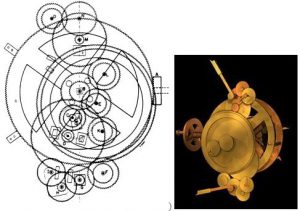
The Antikythera Mechanism Research Project
More than a hundred years ago an extraordinary mechanism was found by sponge divers at the bottom of the sea near the island of Antikythera. It astonished the whole international community of experts on the ancient world. Was it an astrolabe? Was in an orrery or an astronomical clock? Or something else? For decades, scientific investigation failed to yield much light and relied more on imagination than the facts. However research over the last half century has begun to reveal its secrets. It dates from around the 1st century B.C. and is the most sophisticated mechanism known from the ancient world. Nothing as complex is known for the next thousand years. The Antikythera Mechanism is now understood to be dedicated to astronomical phenomena and operates as a complex mechanical “computer” which tracks the cycles of the Solar System.
Previous researchers have used the latest technologies available to them-such as x-ray analysis-to try to begin to unravel its complex mysteries. Now a new initiative is building on this previous work, using the very latest techniques available today. The Antikythera Mechanism Research Project is an international collaboration of academic researchers, supported by some of the world’s best high-technology companies, which aims to completely reassess the function and significance of the Antikythera Mechanism. Results are already very promising.
The project is under the aegis of the Hellenic Ministry of Culture and is supported by a grant from the Leverhulme Trust, UK. It has received strong backing from the National Archaeological Museum in Athens, which is custodian of this unique artefact. Two of the Museum’s senior staff, Head of Chemistry, Eleni Magkou, and Archaeologist, Maria Zafeiropoulou, have co-ordinated the Museums side of the project and are actively involved with the research.
One UK and two Greek universities are the core of the academic research group-the astronomer Mike Edmunds and the mathematician Tony Freeth (University of Cardiff), the astronomer John Seiradakis (University of Thessalonica), the astronomer Xenophon Moussas and the physicist, Yanis Bitsakis (University of Athens). And last, but not least, the philologist and palaeographer Agamemnon Tselikas (NBG Cultural Foundation).
During the first data-gathering phase in the autumn of 2005, the most innovative technologies were used to reveal unknown elements of the mechanism. This research was carried out by two world-class high technology companies, Hewlett Packard (US) and X-Tek Systems (UK). X-Tek`s superb three-dimensional x-rays were imaged using software from the leading German company, Volume Graphics. Technical support was also provided by the University of Keele (UK). The whole process was filmed by Tony Freeth’s Film and Television production company, Images First, for a forthcoming TV documentary.
During September 2005, three specialized scientists from Hewlett-Packard’s Mobile and Media Systems Laboratory came to Athens with their innovative digital imaging system to examine the surface inscriptions and other features on the Antikythera Mechanism. The HP team-Tom Malzbender, Dan Gelb and Bill Ambrisco-brought with them a remarkable piece of specialist equipment: a dome that surrounds the sample under examination and takes a series of still photos to analyze the three-dimensional structure of the surface. This enables astonishingly detailed examination of fine details such as faded and worn inscriptions. It has been a revelation for the research team. Some examples of their work can be browsed at:
Interactive Relighting of the Antikythera Mechanism
During October 2005, another team of specialists from the cutting-edge company, X-Tek Systems, came to Athens. Led by the company’s pioneering proprietor, Roger Hadland, the group of experts consisted of David Bate, Andrew Ramsey, Martin Allen, Alan Crawley and Peter Hockley. Their aim was to use the very latest x-ray technology to look at the internal structure of the mechanism with its complex and confusing gear trains. With them they brought the prototype of a very powerful new x-ray machine, the eight-tonne “Bladerunner”. Originally designed to search for minute cracks in turbine blades, this machine gives astonishingly detailed three-dimensional x-rays, using the latest “microfocus” x-ray techniques. It has opened a remarkable window on microscopic internal details of inscriptions and gearing at a resolution better than a tenth of a millimetre. Inscriptions can now be read that have not been seen for more than two thousand years and this is helping to build a comprehensive picture of the functions of the Antikythera Mechanism. Some of the initial images from the Blade Runner can be seen at this address:
ANTIKYTHERA MECHANISM RESEARCH PROJECT
This is work-in-progress and results are emerging on a weekly basis as the data is analyzed. Within 2007, more information on the ongoing research will be released here.
At the autumn of 2006, the Antikythera Mechanism Research Project has organized a major conference in Athens to present their research findings. These results promise to open a new chapter in the understanding of this extraordinary mechanism. The conference coincided with the publication of the first results at the journal “Nature”.
0 tuns = 1 katun or cycle of 7200 days ( Antikythera device )
20 katuns = 1 baktun or cycle of 144000 days
20 baktuns =1 pictun or cycle of 2880000 days
20 pictuns = 1 calabtun or cycle of 57600000 days
20 calabtun = 1 kinchiltin = a cycle of 1152000000 days ( Antikythera device ) 20 kinchiltin = 1 alautun = a cycle of 23040000000 days ( Antikythera device )
Need I say more ?
But the biggest bomb shell is still to come, and there are now plans to set up meetings/lectures whereby this will be revealed.
You will leave knowing what light really is, you will know the meaning of morning star and evening star and the tree of life.
You will understand the fall and the tree of good and evil and the true purpose of life.
But remember all I can do is show you the door but you need to enter it.
13-07-2007
Moshiya van den Broek

